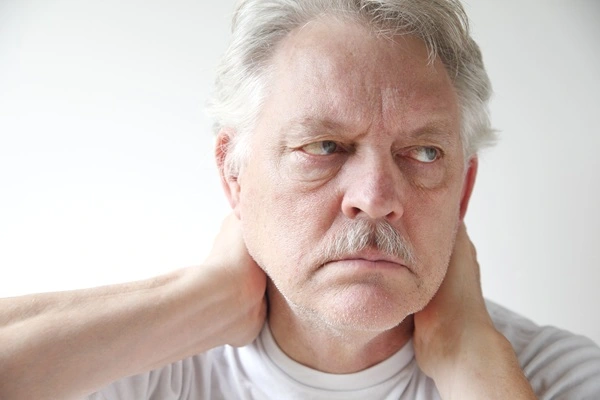Here are seven easy ways to relieve tension headaches. The typical combination of stress, poor posture, old injuries, and repetitive ADL (Activities of Daily Living) create the perfect storm of tension headaches. Specifically, the pain from tension headaches can feel like a “band” around your head. Previously, you may have tried OTC medications to “mask” your pain. As you have probably learned, this is like turning up the radio when your car makes a funny noise. The problem is there, and you can’t hear it. Fortunately, here are seven ways to help relieve tension headaches. Suppose these seven simple things don’t help with your tension headaches; chiropractic adjustments, acupuncture, and laser therapy have great success with many headaches.
Table of Contents
ToggleThe Perfect “Headache Storm”
Because of pressures at work and home, many people suffer from tension headaches. The repetitive nature of our lives can easily cause that pain that starts in the neck and shoulders and slowly creeps to the base of the skull, eventually wrapping around to the temples and forehead.
Tension headache “Triggers”:
- Too much time on a laptop or cell phone
- Driving or sitting for long periods without changing position
- Playing video games for hours without a break
- Grinding your teeth or clenching your jaw
- Stomach sleeping
Given that these activities put the cervical spine in a “stressed” position, the muscles and joints in the neck are stretched and irritated. This increased muscle and joint tension leads to tension headaches. In reality, “overworking” any muscle will lead to pain and muscle spasms.
Tension Headache Symptoms:
- Gradual onset of the headache
- The headache is bilateral (the headache exists on both sides)
- The headache is “dull” or may feel like a band or vice tightening around your head
- Headache pain is stronger at the base of the skull near the neck
- While uncomfortable, the headache is usually “moderate”, not severe
Chronic vs. Episodic Tension Headaches
Episodic tension headaches often result from stressful event(s). They come on quickly and are pretty painful. Episodic headaches tend to go away once the stressful event is over or you take an OTC medication.
Unquestionably, chronic tension headaches occur daily for most of our patients. Often, they occur first thing in the morning or later, at the end of a long work day or busy weekend. Because of constant or at least frequent stress, the muscle contractions in the neck, attached to the skull’s base (occiput), can remain contracted. Unfortunately, the pain from this increased muscle tension can also radiate to the temples and forehead if left untreated.
What are the Differences Between Cervicogenic and Tension Headaches?
Cervicogenic headaches are secondary headaches that originate from issues in the cervical spine, particularly due to neck problems like joint dysfunction or muscle strain. Pain is usually one-sided, starting at the back of the head or neck and radiating forward, often accompanied by restricted neck movement. In contrast, tension-type headaches are primary headaches characterized by a bilateral, pressing or tightening sensation around the head, often described as a “band” around the forehead. These headaches are not typically related to neck dysfunction and are more associated with stress, muscle tension, or fatigue.
Seven Easy Ways to Relieve Tension Headaches
To prevent or ease tension headaches, try the following:
- Start with drug-free treatment: Chiropractic adjustments, laser therapy, and acupuncture treatment (or a combination) have an excellent track record for relieving tension headaches.
- Take some breaks: Limit your time looking down at your phone. Take breaks on long drives.
- Adjust how you sleep: Try sleeping on your back or side with a body pillow and your neck in a neutral posture.
- Exercise and stretch: Use a cane or a hard therapy ball to massage or stretch your neck and shoulder muscles.
- Use over-the-counter medicines: Aspirin, ibuprofen, or acetaminophen is practical for episodic tension headaches. While helpful, they are not a long-term fix for your headaches.
- Minimize your stress: Try to reduce stress by avoiding or limiting stressful events. Keeping a “Headache diary” can help you pinpoint some of the things that can trigger your headaches and may even prevent tension headaches.
- Most Importantly, visit your Chiropractor. Spinal misalignments (Subluxations) in the neck and upper back can cause nerve pressure, joint inflammation, and muscle spasms, resulting in tension headaches!
Unquestioningly, many will reach for an over-the-counter pain reliever when sensing a headache developing. But have you considered a more natural alternative to relieve tension headaches? Research shows that affordable chiropractic care, without medication, can effectively treat various headaches without the dangerous side effects associated with many pain medicines.
Chiropractic is the Best of the Seven Ways to Relieve Tension Headaches
However, according to the American Chiropractic Association, spinal manipulation is an effective tension headache treatment option for many sufferers. Chiropractic adjustment can improve acute and chronic neck pain and reduce the frequency and duration of your headaches. Naturally, that includes migraines, tension, or cluster headaches. Research shows that over 50% of headaches are “Cervicogenic, ” meaning they come from the neck. Above all, Chiropractic adjustments improve motion in the cervical spine, relieve muscle spasms in the neck, and relieve pressure on the spinal nerves. Other improvements include reducing nausea or vomiting when headaches become too severe.
Can Chiropractic be Combined With Other Therapies for Better Headache Management?
Chiropractic adjustments can be effectively combined with other therapies for enhanced headache management. Techniques like manual traction, soft tissue massage, and physical therapy can be added to address muscle tension and improve joint function. Acupuncture has also been explored as a complementary therapy, with some studies suggesting that combining it with chiropractic adjustments can provide additional relief for migraines, though results vary depending on the individual. These integrated approaches allow for a multifaceted treatment strategy that targets both the skeletal and soft tissue contributors to headache pain.
Integrative Health and Rehabilitation providers are experts in finding the cause of your headaches and using the suitable treatment for your specific type of headache. Ready to start feeling better? Looking for a Denver Chiropractor? Book an appointment online or call (303) 424-7171. Want to hear from some of our happy, pain-free patients? Check out some of our 5-Star reviews to learn why we are the chiropractor Denver seeks for fast, effective, and lasting pain relief. Our affordable Chiropractic office is conveniently located for patients in Arvada, Denver, and Wheat Ridge, Colorado!

Ready for an expert opinion? Get in touch today!
With a legacy of more than 25 years, our team specializes in helping individuals triumph over back pain, neck discomfort, and persistent headaches, all without relying on addictive medications or risky surgical procedures.






